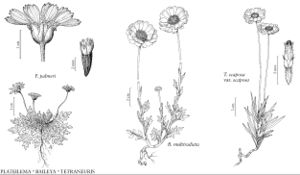Baileya
in W. H. Emory, Not. Milit. Recon., 143. 1848.
| Taxon | Illustrator ⠉ | |
|---|---|---|
 | Plateilema palmeri Baileya multiradiata Tetraneuris scaposa var. scaposa | Linda Ann Vorobik Yevonn Wilson-Ramsey Yevonn Wilson-Ramsey |
Annuals, biennials, or perennials, 15–100 cm. Stems erect, branched from bases or ± throughout, floccose-woolly. Leaves basal and cauline; alternate; petiolate (basal) or sessile (cauline); blades lance-linear to broadly ovate, sometimes pinnately lobed or pinnatifid, ultimate margins entire, faces usually floccose-woolly. Heads radiate, borne singly or in cymiform arrays. Involucres campanulate to hemispheric, 5–25 mm diam. Phyllaries persistent, 8–13 or 21–34 in 2 series (spreading to erect in fruit, distinct, mostly lance-linear, subequal, floccose-tomentose). Receptacles flat to convex, shallowly pitted, epaleate. Ray-florets 5–7 or 20–55, pistillate, fertile; corollas (usually marcescent) yellow. Disc-florets 10–20 or 40–100+, bisexual, fertile; corollas yellow (hairy), tubes shorter than throats, lobes 5, ± deltate (anther appendages ovate; style-branch apices truncate to acute). Cypselae narrowly obpyramidal, weakly ribbed or striate, glandular-pubescent; pappi usually 0 (rarely of scales). x = 16.
Distribution
sw United States, n Mexico
Discussion
Species 3 (3 in the flora).
Baileya is perhaps best known by B. multiradiata, which is the most widely distributed, most abundant, and (usually) earliest blooming of the three species in the genus. The large-headed vernal form is particularly attractive; this, together with its long flowering season and its drought tolerance, have given the plant recognition in horticultural circles.
Selected References
Lower Taxa
Key
| 1 | Heads in loose, cymiform arrays; rays mostly 5–7 | Baileya pauciradiata |
| 1 | Heads borne singly; rays 20–55 | > 2 |
| 2 | Peduncles (at least in vernal forms) 10–30 cm; style-branch apices truncate to slightly rounded | Baileya multiradiata |
| 2 | Peduncles 3–12 cm; style-branch apices ± acute | Baileya pleniradiata |